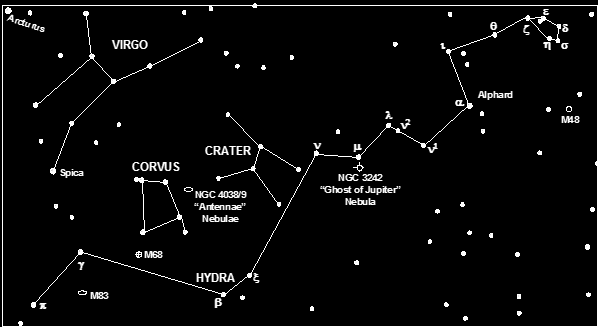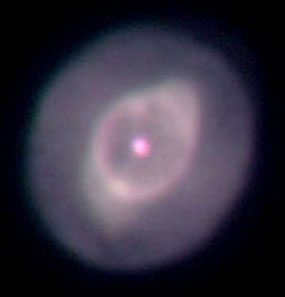HYDRA
Hydra, with an area of 1,303 square degrees, is the largest constellation in the sky.
Alphard: Hydra’s brightest star. At second magnitude it is similar in brightness to Polaris. Its name means “Solitary One”, which is apt since it lies in an otherwise barren region of the sky.
M 48: Large open cluster, well seen with binoculars. Charles Messier who discovered it in 1771 gave a position for M48 in his famous catalogue which was incorrect by 4o. Nevertheless there are no other similar objects in the vicinity and therefore little chance of mistaken identity.

NGC3242 ("Eye" or “Ghost of Jupiter” Nebula)
M 68: Globular cluster also discovered by Messier. M68 is at a greater distance from us than M13, the great globular cluster in Hercules, so is less spectacular. Nevertheless it is a decent object for small telescopes, if a little southerly for UK observers.
M 83: One of the brightest and closest of the galaxies, sometimes known as the “Southern Pinwheel”. It is a barred spiral with three distinct spiral arms. Unfortunately however it lies too far south to be easily observed from the UK.
NGC 4038/9 (“Antennae” Nebulae): A pair of 11th magnitude interacting galaxies in the neighbouring constellation of Corvus. Somewhat similar to, but considerably brighter than “The Mice” pair (NGC 4676) in Coma Berenices which were imaged at our Faulkes session.
The Largest and Smallest Constellations: Hydra, with an area of 1,303 square degrees, has been the largest constellation in the sky since the ancient southern constellation of Argo Navis got divided up into Puppis, Vela and Carina in the 18th century. Next largest is Virgo (1,294 square degrees) which was featured in last month’s notes and third largest is Ursa Major (1,280 square degrees), featured two months ago. The three smallest constellations are; Crux (68 square degrees), Equuleus (72 square degrees) and Sagitta (80 square degrees).
POWERPOINT SLIDE SHOW (313KB)